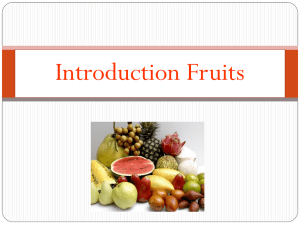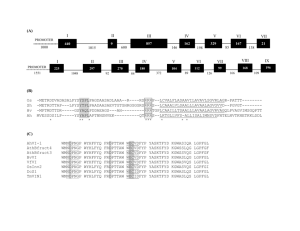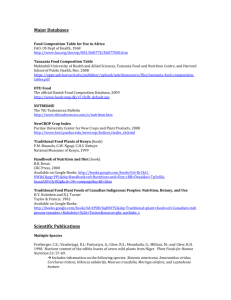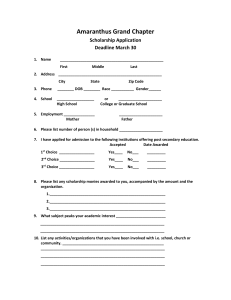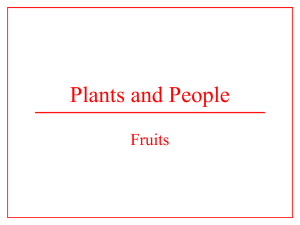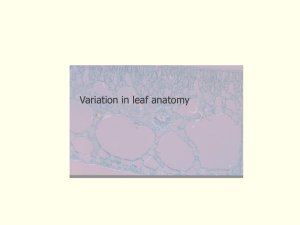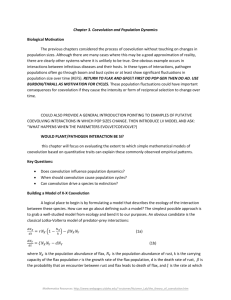Anatomy_of_fruit_last
advertisement
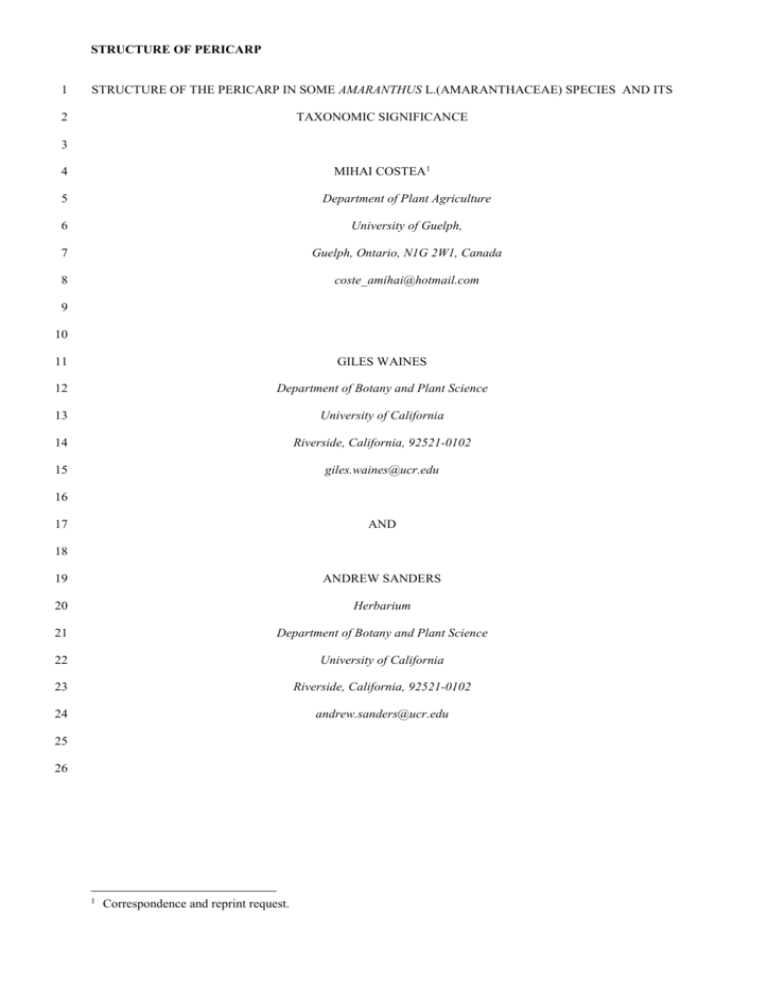
STRUCTURE OF PERICARP 1 STRUCTURE OF THE PERICARP IN SOME AMARANTHUS L.(AMARANTHACEAE) SPECIES AND ITS 2 TAXONOMIC SIGNIFICANCE 3 MIHAI COSTEA1 4 5 Department of Plant Agriculture 6 University of Guelph, 7 Guelph, Ontario, N1G 2W1, Canada 8 coste_amihai@hotmail.com 9 10 11 GILES WAINES 12 Department of Botany and Plant Science 13 University of California 14 Riverside, California, 92521-0102 15 giles.waines@ucr.edu 16 17 AND 18 19 ANDREW SANDERS 20 Herbarium 21 Department of Botany and Plant Science 22 University of California 23 Riverside, California, 92521-0102 24 andrew.sanders@ucr.edu 25 26 1 Correspondence and reprint request. STRUCTURE OF PERICARP 1 Mihai Costea, Giles Waines & Andrew Sanders ABSTRACT 2 3 In order to determine their taxonomic significance, 10 pericarp structure characters were scored for 21 4 Amaranthus L. taxa. In many, pericarp patterns permit recognition of the taxa as species. Differences between 5 cultivated taxa and their wild relatives offer new arguments against their taxonomic union. The relationships 6 between other closely related taxa are also analyzed (A. quitensis and A. hybridus; A. bouchonii and A. powellii; 7 A. hybridus and A. powellii; A. blitum and A. emarginatus). The mechanism of dehiscence and terminology for 8 the fruit of Amaranthus are considered. 9 10 11 12 13 14 15 16 17 18 19 20 21 22 23 24 25 26 27 28 29 30 Key words: Amaranthus, fruit anatomy, pericarp, taxonomy, carpology. 2 STRUCTURE OF PERICARP 1 2 Mihai Costea, Giles Waines & Andrew Sanders 3 INTRODUCTION The genus Amaranthus includes mostly wild and weedy, but also some domesticated vegetable, grain- 3 crop and ornamental species. Although the taxonomy of this genus has been the subject of many previous 4 studies, the problems in the “hybridus” and “blitum” groups have not been resolved. The relationship between 5 the cultivated taxa and their presumed wild progenitors needs resolution in the grain amaranths. The taxonomic 6 treatment of the A. hybridus group of species ranges between two different extremes with many intermediates. 7 At one extreme is Sauer's treatment (1967), which recognises the cultivated taxa (Amaranthus caudatus, A. 8 cruentus and A. hypochondriacus) as species, while at the other extreme is Greuter’s treatment (1981), which 9 unites the cultivated species with their supposed wild progenitors (A. quitensis, A. hybridus and A. powellii 10 respectively) without any further infraspecific classification. We studied anatomical aspects of the pericarp in 11 order to re-evaluate these taxonomic relationships. 12 According to Judd (1985) and Spjut (1994), the genus Amaranthus has two types of fruit: "pyxidium" 13 (or "pyxis") and "utricle". The question is, has Amaranthus two different types of fruit? Another question is the 14 mechanism of fruit dehiscence and the taxonomic significance of fruit dehiscence. The case of closely related A. 15 bouchonii and A. powellii is well known in Europe (Costea et al. 2001a). The main morphological difference 16 between the two is that A. powellii has dehiscent fruits, whereas A. bouchonii has indehiscent fruits. Presumably, 17 the latter originated from the former by a relatively simple mutation. Amaranthus bouchonii, which is very 18 widespread in Europe, was regarded as conspecific with A. powellii by Sauer (1967), Carretero (1990) and 19 Akeroyd (1993), but maintained at the species level by Hügin (1987), Stace (1991) and Wilkin (1992). The 20 objectives of this study were to evaluate the taxonomic value of pericarp characters in the amaranths and to see 21 if they provide additional perspectives on the taxonomic problems briefly discussed above. Also we analysed 22 the mechanism of dehiscence and the carpologic nomenclature for the fruit of amaranths. 23 24 MATERIALS AND METHODS 25 Twenty-one taxa representing 17 species and six infraspecific taxa (Table 1) were scored for 10 26 anatomical characters pertaining to the fruits. Fruits were collected by Costea, either from the wild flora (mainly 27 from Romania and Spain), or from cultivated accessions provided by the USDA and Gatersleben germplasm 28 collections (the latter marked in the table with “*”) (Table 1). Voucher specimens are preserved in the BUAG 29 herbarium collection, except for the USDA accessions, which are preserved in US. Twenty fruits were collected 30 from each plant, and 15–20 different plants for each species were taken into account. Fruits were fixed in STRUCTURE OF PERICARP Mihai Costea, Giles Waines & Andrew Sanders 1 formalin-acetic acid-alcohol (5:5:90) (FAA) and embedded in paraffin. Transverse and longitudinal sections 2 were made at 5–7 m in thickness and stained with Toluidine Blue. Drawings were made with a Reichert 3 camera lucida. The structure of the pericarp is constant immediately above the dehiscence line for the 4 circumcissile fruits, and in the middle zone of the fruit for the indehiscent ones, descriptions referring to these 5 regions. 6 List of pericarp characters examined: 7 1. General appearance of pericarp structure 8 2, two-layered pericarp 9 3, three-layered pericarp 10 4, four-layered pericarp 11 2. Uniformity of epidermis cells size 12 UNI, cells with uniform size 13 VAR, cells with very variable size 14 3. Form of epidermis cells, as seen in transverse section 15 ROU, round 16 RAEL, radial elongated 17 TAEL, tangential elongated 18 SQU, square 19 4. Number of layers of mesocarp 20 0, mesocarp crushed, usually no longer distinguishable 21 1, mesocarp 1-layered 22 2, mesocarp 2-layered 23 5. Orientation of cells in 1-layered mesocarp 24 LONG, cells are preponderantly longitudinally stretched 25 VARS, cells are variously stretched: transversely, longitudinal and obliquely 26 6. Orientation of inner layer of cells in 2-layered mesocarp 27 TRANS, cells are preponderantly transversely extended 28 TLO, cells are variably stretched: transversely, longitudinally and obliquely 29 30 7. Presence of additional, loosely arranged cells in mesocarp with sustaining role 0, absent 4 STRUCTURE OF PERICARP 1 2 Mihai Costea, Giles Waines & Andrew Sanders +, present 8. Adherence between epidermis + mesocarp and endocarp 3 STI, the epidermis + mesocarp and the endocarp are mostly fused 4 DET, the epidermis + mesocarp are mostly detached from the endocarp, resulting in large 5 intercellular spaces: 6 l, the epidermis + mesocarp form intercellular spaces in form of loops 7 p, the epidermis + mesocarp lie parallel to the endocarp, loops not being formed 8 9. Thickening of walls in endocarp cells 9 1, the endocarp cells with the inner and to a less extent the radial walls 10 thickened, while the tangential walls are thin. 11 2, the endocarp cells with either uniform thickened or thin walls 12 2a, walls uniformly thickened 13 2b, walls thin 14 5 10. Adherence between endocarp cells and the seed coat 15 +, a slight adhesion before the fruit dries 16 0, no adhesion observed 17 18 19 RESULTS The data matrix for the 10 pericarp characters is presented in the Table 2. The quantitative 20 characteristics of the pericarp are listed in the Table 3. The structure of pericarp is congruent at species level and 21 all the accessions, populations and infraspecific taxa examined shared the characteristics of their species. 22 Therefore, to avoid redundancy, the infraspecific taxa are not indicated in the tables (with the exception of A. 23 blitum subsp. blitum and subsp. oleraceus which exhibited minute quantitative differences—Tab. 3). As seen in 24 transection, the mature pericarp has a very simple, 2–4 layered structure, consisting of epicarp, mesocarp and 25 endocarp. The epicarp is the epidermis and has thickened cell walls. The size and shape of epidermal cells as 26 seen in transverse section are quite variable in species belonging to subgenus Amaranthus (= section 27 Amaranthus), but fairly uniform in subgenus Albersia (= section Blitopsis Dumort). The thickness of radial cells 28 varies from 30–33 m (A. powellii) to 7–10 m (A. graecizans), and is more or less constant within a species 29 (Table 3). STRUCTURE OF PERICARP Mihai Costea, Giles Waines & Andrew Sanders 1 The mesocarp has one (Fig. 1, 2, 5, 7, 9, 10, 13 and 15) or two layers of cells (Fig. 3, 8 and 14) 2 depending on the species (Table 2). In some species—A. hybridus, A. quitensis (Fig. 6), A. graecizans (Fig. 12), 3 A. blitoides (Fig. 11)—the mesocarp begins as single cell layer but later is crushed and becomes mainly 4 indistinguishable at maturity. As a consequence, in these species the pericarp appears two-layered (Table 2). 5 Size and arrangement of mesocarp cells relative to the epidermal cells are variable, thus providing additional 6 characters. When the mesocarp is one-layered, its cells may be longitudinally or variably oriented relative to the 7 epidermis cells. When the mesocarp is two-layered, the cells from the outer layer are always longitudinally 8 elongated, while the cells from the inner layer may be transversely or variably stretched (transversely, 9 longitudinally or obliquely) (Table 2). The thickness of mesocarp varies from 12–14 m in A. graecizans (Fig. 10 11 12) and 50–70 m in A. blitum (Fig. 14) and is also relatively constant within a species (Table 3). The endocarp is adjacent to the seed coat and consists of a single layer of cells in all taxa examined. 12 Generally, the seed coat and endocarp do not fuse, but, in some species with indehiscent fruits, there is a slight 13 concrescence before the fruit dries (Table 2). When the pericarp is separated from the seed coat, the radial walls 14 of the endocarp cells are ruptured (Fig. 8 and 10). Thus, the inner walls of the endocarp cells together with 15 fragments of the radial walls remain in contact with the seed coat being observable when the fruit is not dried as 16 a thin membrane on the surface of the seed. 17 6 In species with circumcissile fruits, the inner tangential walls and to a lesser extent the radial walls are 18 thickened, whereas the outer tangential walls of the endocarp cells are thin (Fig. 1, 2, 3, 4, 6, 7, 9, 11 and 12). As 19 seen in longitudinal sections, the endocarp is continuous and its cells contain calcium oxalate crystals. Species 20 with indehiscent fruit have endocarp cells either with uniformly thickened walls, or with thin walls, depending 21 on the species (Table 2). The circumcissile dehiscence of fruits is only partly the result of this unequal 22 thickening of endocarp cell walls. 23 The epidermis and mesocarp always adhere, but usually they detach from the endocarp, resulting in 24 large intercellular spaces (Fig. 4, 5, 7, 9, 10, 12 and 13). Distribution, orientation, form and size of these 25 intercellular spaces, in association with the drying of the pericarp, cause a pattern of wrinkling characteristic for 26 each species. When such intercellular spaces are formed, the mesocarp can exhibit additional loosely arranged 27 cells, variable in form, which probably have a mechanical function (Fig. 5, 10, 13). The presence or absence of 28 such cells may have diagnostic value (Table 2). 29 30 In the mesocarp, along the suture lines of the carpels there are 2–3 colateral bundles. The bundles are surrounded by a sheath of radiate, isodiametric cells with thickened walls and large chloroplasts, much like the STRUCTURE OF PERICARP Mihai Costea, Giles Waines & Andrew Sanders 1 “Kranz” bundle-sheath that surrounds the minor veins of leaves (e.g. Haberlandt 1914; Fisher et Evert 1982) 2 Because of the existence of this bundle-sheath, the bundles (and consequently the position of the suture lines of 3 carpels) are usually visible on the fruit surface. 4 7 Based on the material examined, the pericarp structure is extremely simple but provides characters that 5 allow the recognition of many species. Taxonomic significance of the anatomical features of the pericarp is 6 revealed in the “hybridus” and “blitum” groups. Strictly on grounds of their general morphology, especially in 7 the A. hybridus complex, the cultivated species and their wild relatives are very much alike (Table 2). However, 8 based on their pericarp anatomy they are different: the grain amaranths (A. hypochondriacus, A. caudatus and A. 9 cruentus) have a more structurally complex pericarp than their wild relatives (A. powellii, A. quitensis and A. 10 hybridus). Thus, A. hypochondriacus has a two-layered mesocarp, while its morphologically closest species, A. 11 powellii, has a one-layered mesocarp. The same situation applies to A. caudatus (Fig. 3) and A. quitensis (Fig. 12 6), which, beside the different mesocarp, exhibit completely unlike characteristics (Table 2, 3). Similarly, A. 13 cruentus (Fig. 2) and A. hybridus (Fig. 6) have quite distinct qualitative and quantitative anatomical pericarp 14 features (Table 2, 3). Regardless the different hypotheses on the grain amaranths evolution (reviewed by Costea 15 et al. 2001a; Xu and Sun 2001), these facts provide reasonable arguments against assembling the cultivated 16 species together with their wild progenitors. In “hybridus” group, some authors (e.g. Townsend 1988) consider 17 the names A. powellii and A. hybridus taxonomic synonyms. Even if other morphological characters can easily 18 differentiate these taxa, the distinctness of their pericarp anatomy is an additional proof of their individuality 19 (Table 2, 3). In contrast, between A. hybridus and A. quitensis there is an obvious structural resemblance (Table 20 2, 3), supporting the idea of a single species including both taxa (Coons 1978; Costea et al. 2001a). In the 21 “blitum” group, A. emarginatus and A. blitum have dissimilar fruits based on both morphological (Costea et al. 22 2001b) and anatomical characters. Thus, A. emarginatus has a three-layered, thin pericarp (18–25 m, Fig. 15) 23 while A. blitum has four-layered, thicker pericarp (50–70 m, Fig. 14) (Tables 2 and 3). These data support the 24 specific rank for A. emarginatus as proposed by Hügin (1987). 25 26 DISCUSSION 27 Mechanism of fruit dehiscence and wrinkling pattern 28 Both dehiscent (irregularly or circumscissile) and indehiscent fruits in Amaranthus originate from the 29 same type of syncarpous, two or three carpelar, unilocular and uniovulate gynoecium. In other words, there is no STRUCTURE OF PERICARP Mihai Costea, Giles Waines & Andrew Sanders 1 fundamental difference between the ovary of dehiscent and indehiscent fruits. Circumscissile dehiscence is the 2 result of additional elements: 3 a) As seen in longitudinal section, a band of meristematic cells differentiate in the middle region of 4 the ovary. This zone will constitute a region of mechanical weakness along with the pericarp will 5 rupture producing dehiscence. 6 b) Mature cells of the endocarp acquire special thickenings in the inner, and to a less extent the radial 7 walls, while the external tangential walls remain thin. 8 c) 9 d) Development of seed within the cavity of the ovary and pressure exercised by the neighbouring 10 11 Drying of fruits, achieved at maturation. flowers and fruits. If the first two structural conditions are not realised, the fruit is always indehiscent. If the weakness line 12 does not differentiate, the fruit will split irregularly or will remain indehiscent. If a weakness area exists but the 13 endocarp cells have evenly thickened walls, the fruit may remain indehiscent (even if the dehiscence line is 14 visible) or will have circumscissile dehiscence. The dehiscence mechanism is very much like the one described 15 for Celosia argentea and Sesuvium portulacastrum (Subramanyam et Raju 1953), Plantago sp. (Rethke 1946) 16 and Anagallis pumila (Raju 1952). The wrinkling pattern of the fruits is the consequence of the interaction 17 between the overall architecture of pericarp in combination with drying. 18 8 The dehiscence-indehiscence character involves probably two or a few Mendelian genes (reviewed by 19 Brenner et al. 2000) but further research should clarify this point. The indehiscence character state is also an 20 important breeding objective for grain amaranths because amaranth seeds are prone to shatter (Brenner et 21 Hauptli 1990). In this respect, some results have already been obtained. The indehiscence trait has been 22 transferred from A. powellii (A. bouchonii?, PI 572261) to A. cruentus and A. hypochondriacus using traditional 23 breeding techniques (Brenner et al. 2000). 24 The fruit in Amaranthus and its taxonomic significance 25 These new data illuminate the following questions: what is the fruit type in Amaranthus and what is the 26 significance of dehiscence for the taxonomy of the genus? Using the categories provided by some systems of 27 fruit classification (e.g. Gusuleac 1939; Egler 1943; Winkler 1939, 1940; Baumann-Bodenheim 1954; Judd 28 1985; Spjut 1994), Amaranthus fruits always fall into one of two categories. The indehiscent fruit is called 29 “utricle” in the American literature or usually “achene” in the European literature (e.g. Aellen 1959; Ciocarlan 30 1988; Stace 1991). The circumscissile fruit is commonly called “pyxidium (pyxis)” or sometimes "capsule" STRUCTURE OF PERICARP Mihai Costea, Giles Waines & Andrew Sanders 1 (Townsend 1988) or "one-seeded capsule” (Stace 1991). The irregular dehiscent condition is not named 2 separately but is considered a deviation of the above mentioned types. 3 9 The problem is that in Amaranthus the gynoecium presents no variation and that the anatomical 4 differences between indehiscent and the circumscissile fruits are extremely small. The best example is offered 5 by A. powellii and A. bouchonii. The first has circumscissile fruits, while the second has indehiscent ones. 6 Structurally, they differ by formation of a transverse zone of weakness and by the different manner of wall 7 thickenings in the endocarp cells. Except for these anatomical peculiarities achieved at maturity, there are no 8 other differences between the circumscissile and indehiscent fruits in Amaranthus. Therefore, on the basis of 9 the ontogeny and the structural organisation of the pericarp, the two fruit “types” in Amaranthus are only 10 functional variants of a single fruit type. However, choosing terms for the Amaranthus fruit is not simple. In 11 Amaranthaceae and Chenopodiaceae many genera have irregularly dehiscent fruits. Sometimes, (as in 12 Chamissoa) all intermediates between irregular dehiscent fruits and circumcissile dehiscent fruits may be 13 observed (Eliasson 1988). The same range of circumscissile, irregularly dehiscent, and indehiscent fruits occurs 14 in populations of A. hybridus from Mexico (Costea et al. 2001a). In such situations, circumscissile dehiscence 15 should be considered more as a tendency than as a constant character. Some species with usually circumscissile 16 fruits (e.g. A. powellii, A. hybridus, A. retroflexus and A. albus) can also form irregularly dehiscent and 17 indehiscent fruits even on the same plant (Tucker et Sauer 1958; Costea et al. 2001a). In contrast, species with 18 indehiscent fruits never produce plants with circumscissile or irregularly dehiscent fruits. Therefore, 19 indehiscence in Amaranthus could be plesiomorphic and the circumscissile transversal dehiscence appears to be 20 derived. However, in some situations (e.g. A. bouchonii) indehiscence may have evolved again from the 21 circumscissile dehiscence. As Cronquist (1988) stated, the advantages of circumscissile dehiscence are obscure 22 since the entire fruit could act as a single unit of dispersal. There is apparently no correlation between fruit 23 dehiscence and indehiscence and the success of various amaranth species as weeds. Species with dehiscent fruits 24 are noxious weeds (e.g. A. retroflexus, A. hybridus, A. powellii and A. palmeri), but the same is also true of some 25 species with indehiscent fruits (e.g. A. viridis and A. blitum). Sometimes the dehiscence mechanism can be 26 easily lost because the genetic causes of indehiscence are not selected against (Cronquist 1988). In such cases, 27 irregular dehiscence can be regarded as an intermediate step between circumscissile dehiscent and indehiscent 28 fruit variants. 29 30 Taking into account the absence and impossibility to build a generally accepted system of fruit classification, it is beyond the scope of this paper to resolve the carpologic nomenclature for Amaranthus. The STRUCTURE OF PERICARP Mihai Costea, Giles Waines & Andrew Sanders 10 1 following considerations are only a survey of the available possibilities. “Amaranthocarpium” of Kaden and 2 Kirpieznikov (1965) with its two variants: “dehiscens” (in A. albus) and “indehiscens” (in A. blitum = A. 3 lividus), is difficult to accept—even if correct from a phyllogenetic perspective—because this would involve the 4 acceptance of the other many hundreds of names that should be used for the fruits of other plants. The other 5 available terms are "utricle" and "achene." The definition of utricle of Judd (1985) and Spjut (1994, without the 6 word "dehiscent") would be appropriate for the fruit of Amaranthus. For example, the characterisation of 7 Amaranthus fruit as given by Gleason and Cronquist (1991) "a thin-walled to coriaceous utricle, indehiscent 8 or bursting irregularly, or commonly circumscissile at the middle, crowned by the persistent stigmas" is 9 satisfactory. Unfortunately as Spujt (1994) showed, “utricle” is a confusing term because as a fruit type it was, 10 and still is used to refer either to the one-seeded capsule with circumcissile dehiscence, or to the one-seeded, 11 indehiscent bladdery fruit, or even both situations together. More than that, the term “utricle” is also often used 12 for the sac that surrounds the fruit of Carex. European authors preferred the term "achene", because of the above 13 confusion on the name "utricle" and because it is considered that the thickness of pericarp is not enough to 14 support two different type of fruits ("utricle" and "achene"). The symmetrical variant would be a "circumscissile 15 (transversal dehiscent) "achene." If adjectival terms that contradict with the common definition of a 16 carpological nomenclatural type are not to be used (Spjut 1994), the simplest approach would be to avoid 17 entirely naming the fruit in Amaranthus (and Amaranthaceae), as an increasing number of authors have done 18 lately (e.g. Eliasson 1988; Akeroyd 1993), referring to it as circumscissile, irregular dehiscent or indehiscent as 19 appropriate. 20 In Europe, the dehiscence character is apparently constant within a line. Mixed European populations 21 of A. bouchonii, A. powellii, A. hybridus and A. retroflexus were observed to maintain their original character 22 (Costea et al. 2001a). Segregation is possible, but occurs at low frequencies. In North America, individuals of A. 23 powellii and A. hybridus with indehiscent fruits are more variable than in Europe. In both, a single plant may 24 bear only indehiscent fruits (especially A. powellii) or both dehiscent and indehiscent fruits (especially A. 25 hybridus). Sometimes the dehiscence zone is partially visible but the fruit does not open (weakness zone present, 26 but cell endocarp with no special thickenings in the walls). After surveying the most important herbarium 27 collections in the United Sates it became obvious that European-like A. bouchonii occurs here too (Costea et al. 28 2001a). Perhaps the process of evolution of this taxon has been taking place simultaneously in North America 29 and Europe, acquiring more stability and consistency on the latter continent. It is obvious that the dehiscence 30 character can not support recognition at species level for taxa as A. bouchonii. Pratt and Clark (2001) reached STRUCTURE OF PERICARP Mihai Costea, Giles Waines & Andrew Sanders 11 1 the same conclusion in a similar case: A. tuberculatus (Moq.) Sauer and A. rudis Sauer. However, the 2 dehiscence character may be significant at infraspecific level. For example, Costea et al. (2001a) proposed A. 3 bouchonii as a subspecies of A. powellii. The two variants of A. powellii in Europe have a different ecology: 4 subsp. bouchonii occurs primarily along riverbanks as pioneers, while subsp. powellii is a ruderal or agrestal 5 weed. The seeds of subsp. bouchonii can be water-dispersed at longer distances than the seeds of subsp. powellii 6 because of the extensive intercellular spaces present in the pericarp, which insure a better floatability. 7 Additionally, the indehiscent fruits of subsp. bouchonii may enhance the imbibition of seeds during germination. 8 In conclusion, based on the material studied, the structural characteristics of pericarp support the 9 separate recognition of cultivated grain amaranths from their wild relatives. The anatomical features of pericarp 10 can supplement the morphological characteristics of fruits described by Costea et al. (2001a) in the identification 11 of Amaranthus species. The dehiscence character in closely related Amaranthus taxa (e.g. A. powellii and A. 12 bouchonii) may be significant only at infraspecific level. However, because the genus Amaranthus comprises 13 approximately three times more species than were examined in the present study and some of these species are 14 very variable and widespread, more material should be examined before definite conclusions can be reached. 15 16 17 18 ACKNOWLEDGEMENTS Many thanks go to Richard Spjut, Norman Ellstrand, Darleen DeMason, David Brenner and two 19 anonymous reviewers who contributed with helpful criticism and suggestions, which improved previous 20 versions of the manuscript. The paper was written during first author’s Fulbright scholarship at University of 21 California, Riverside. 22 23 24 25 26 27 28 29 30 STRUCTURE OF PERICARP 1 Mihai Costea, Giles Waines & Andrew Sanders 12 LITERATURE CITED 2 3 4 5 AELLEN, P. 1959. Amaranthus L. pp. 465–516. In G. Hegi, Illustrierte Flora von Mitteleuropa, (2-nd ed.), Vol. 3, Part. 2, München. AKEROYD, J. 1993. Amaranthus L. pp. 130–132. In: T. G. Tutin, N. A. Burges, A. O. Chater, J. R. 6 Edmondson, V. H.Heywood, D. M. Moore, D. H. Valentine, S. M. Walters and D. A. Webb [eds.], Flora 7 Europaea (2-nd ed.), Vol. 1, University Press, Cambridge. 8 9 10 11 BAUMANN-BODENHEIM, M.G. 1954. Prinzipien eines Fruchtsystems der Angiospermen. Ber. Schweiz. Bot. Ges. 64: 94–112. BRENNER, D. M., AND H. HAUPTLI. 1990. Seed shattering control with indehiscent utricles in grain amaranths. Legacy 3: 2–3. 12 ___________, D. D. BALTENSPERGER, P. A. KULAKOW, J. W. LEHMANN, R. L. MYERS, M. M. SLABBERT, AND 13 B. B. SLEUGH. 2000. Genetic resources and breeding of Amaranthus. Plant Breeding Rev. 19: 227–112. 14 CARRETERO, J. L. 1990. Amaranthus L. pp. 554–569. In: S. Castroviejo, M. Lainz, G. Lopez Gonzales, P. 15 Montserrat, F. Munoz Garmendia, J. Paiva and L. Villar [eds.], Flora Iberica. Plantas vasculares de la 16 Peninsula Iberica e Islas Baleares, Vol. 2, Platanaceae-Plumbaginaceae. Jardin Botanico, Madrid. 17 CIOCARLAN, V. 1988. Illustrated Flora of Romania. Vol. I, Ed. Ceres, Bucharest (in Romanian), 340 p. 18 COONS, M. P. 1978. The status of Amaranthus hybridus L. in South America. The taxonomic problem. Ci. 19 20 21 22 23 24 25 26 27 Naturaleza. 19: 66–71. COSTEA, M., G. WAINES, AND A. SANDERS. 2001a. Preliminary results toward a revision of the Amaranthus hybridus species complex. Sida 19: 931–934. ___________, G. WAINES, AND A. SANDERS. 2001b. Notes on some little known Amaranthus taxa (Amaranthaceae) in the United States. Sida 19: 975–992. CRONQUIST, A. 1988. Fruits and seed dispersal. pp. 237–240. In: The evolution and classification of flowering Plants, 2-nd ed., New York Botanical Garden. ELIASSON, U. 1988. Floral morphology and taxonomic relation among genera of Amaranthaceae in the New World and the Hawaiian Islands. J. Linn. Bot. Soc. 96: 235–283. 28 EGLER, F. E. 1943. The fructus and the fruit. Chron. Bot. 7: 391–395. 29 FISHER, D. G., AND R. F. EVERT. 1982. Studies on the leaf of Amaranthus retroflexus L.: morphology and 30 anatomy. Amer. J. Bot. 69: 1133–1147. STRUCTURE OF PERICARP 1 2 GLEASON, A. AND, A. CRONQUIST. Mihai Costea, Giles Waines & Andrew Sanders 1991. Amaranthus L. pp.104–108. In Manual of vascular plants of Northeastern United States and adjacent Canada, 2-nd ed., New York Botanical Garden. 3 GREUTER,W. 1981. Med-Checklist Notulae 3. Willdenowia 11: 3–43. 4 GUSULEAC, M.1939. Zur Präzisierung de Nomenklatur der Früchte und der Prinzipien eines natürlichen 5 Fruchtsystems. Bul. Fac. Sti. Cernauti 12 (1938): 337–355. 6 HABERLANDT, G.1914. Physiological Plant Anatomy. Macmillan London, 777 p. 7 HÜGIN, G. 1987. Einige Bemerkungen zu wenig bekannten Amaranthus -sippen (Amaranthaceae) 8 9 10 11 12 13 14 Mitteleuropas. Willdenowia 16: 453–478. JUDD, W. S. 1985. A revised traditional descriptive classification of fruits for the use in floristics and teaching. Phytologia 58: 233–242. KADEN, N. N., AND M. E. KIRPIEZNIKOV. 1965. A possible contemporary system of fruit terminology. Taxon 14: 219–223. PRATT, D. B., AND L. G. CLARK. 2001. Amaranthus rudis and A. tuberculatus—one species or two? J. Torr. Bot. Soc. 128: 282–296. 15 RAJU, M. V. S. 1952. Embriology of Anagallis pumila Swartz. Proc. Indian Acad. Sci. B, 36: 34–42. 16 RETHKE, R. V. 1946. Circumscissile dehiscence in some angiosperms. Amer. J. Bot. 33: 677–683. 17 SAUER, J. D. 1967. The grain amaranths and their relatives: A revised taxonomic and geographic survey. Ann. 18 13 Missouri Bot. Gard. 54: 103–137. 19 SUBRAMANYAM, K., AND M. V. R A J U. 1953. Circumscissile dehiscence. Amer. J. Bot 40: 571–574. 20 SPJUT, R. W. 1994. A systematic treatment of fruit types. Mem. New York Bot. Gard. Vol. 70, 182 p. 21 STACE, C. A. 1991. Amaranthus L. pp. 186–190. In New Flora of British Isles, Cambridge. 22 TOWNSEND, C. C. 1988. Amaranthus. pp. 45–60. In: E. Launert [ed], Flora Zambesiaca Vol 9, part I, London. 23 TUCKER, J. M., AND J. D. SAUER. 1958. Aberrant amaranth populations of the Sacramento-San Joaquin Delta, 24 25 26 California. Madrono 14: 252–261. WILKIN, P. 1992. The status of Amaranthus bouchonii Thell. within Amaranthus L. subgenus Amaranthus: new evidence from morphogy and isoenzyme. Journ. Linn. Soc. Bot. 108: 253–267. 27 WINKLER, H. 1939. Versuch eines "naturlichen" Systems der Früchte. Beitr. Biol. Pflanzen 1: 201–220. 28 WINKLER, H. 1940. Zur einigung und Weiterführung in der Frage des Fruchtsystems. Beitr. Biol. Pflanzen 2: 29 92–130. STRUCTURE OF PERICARP Mihai Costea, Giles Waines & Andrew Sanders 14 1 XU, F., AND M. SUN. 2001. Comparative analysis of phylogenetic relationships of grain 2 amaranths and their wild relatives (Amaranthus; Amaranthaceae) using internal transcribed spacer, amplified 3 fragment length polymorphism, and double-primer fluorescent intersimple sequence repeat markers. Mol. Phyl. 4 Evol. 21: 372–387. 5 6 STRUCTURE OF PERICARP 1 2 Mihai Costea, Giles Waines & Andrew Sanders TABLES Table 1. Provenance of Amaranthus taxa (Amaranthaceae) examined for pericarp features. 3 Taxa Voucher No. Provenance or accession Subgenus Acnida (L.) Aellen ex K. R. Robertson A. rudis Sauer 23033 (a–j) Romania 23050 (a–j) Romania (k–s) Mexico* Subgenus Amaranthus (= section Amaranthus) A. caudatus L. A. cruentus L. Ames 2026 Nepal PI 16604 India PI 490440 Peru 23037 (a–j) Romania (k–s) A. hypochondriacus L. PI 566896 Arizona, USA PI 566897 India PI 511919 Guatemala 22769 (a–j) Romania (k–s) A. powellii S. Wats. Mexico 22770 (a–j) Romania 23041 (a–j) (k–s) A. hybridus L. 22721 (a–j) (k–s) A. quitensis Kunth India* PI 511 721 (k–s) A. bouchonii Thell. India* Spain Romania Spain Romania Spain 22840 (a–j) Romania (k–s) Ecuador* 15 STRUCTURE OF PERICARP Mihai Costea, Giles Waines & Andrew Sanders A. retroflexus L. 21822 (a–j) (k–s) Romania Spain Subgenus Albersia (Kunth)Gren. & Godr. (= Section Blitopsis Dumort.) A. albus L. 21800 (a–j) (k–s) A. blitum L. subsp. blitum A. emarginatus Moq. ex Uline & Bray = A. blitum subsp. emarginatus (Moq. ex Uline & Bray) Carretero, Munoz Garmendia & Pedrol A. viridis L. Canada 23049 (a–j) Romania Germany* PI 606 281 Bangladesh 22996 (a–j) Romania (k–s) Spain Ames 23387 Brasil Ames 14964 India 23034 (a–j) Romania 23045 (a–j) (k–s) A. blitoides S. Wats. var. reverchonii Uline & Bray Spain Romania Spain PI 553 059 Canada PI 608 663 USA 23046 (a–j) Romania (k–s) A. graecizans L. var. graecizans Germany* 23051(a–s) (k–s) A. blitoides S. Wats. var. blitoides Spain Ames 13788 (k–s) A. blitum subsp. oleraceus (L.) Costea Romania 23042 (a–j) (k–s) Russia Romania Germany* A. graecizans var. sylvestris (Vill.) Thell. 2632 (a–j) Romania A. crispus (Lesp.& Thev.) N. Terraciano 22225 (a–j) Romania A. deflexus L. 22228 (a–s) Romania Spain 16 STRUCTURE OF PERICARP 17 Mihai Costea, Giles Waines & Andrew Sanders Table 2. Data matrix for the 10 pericarp characters for the 17 species of Amaranthus (Amaranthaceae) Taxa 1 2 3 4 5 6 7 8 9 10 Amaranthus caudatus 4 VAR ROU/RAEL 2 ___ TRANS 0 STI 1 - A. cruentus 3 VAR RAEL 1 LONG _____ 0 STI 1 - A. hypochondriacus 4/3 VAR ROU/RAEL 2/1 LONG TLO + DETl 1 - A. powellii 3 VAR RAEL 1 VARS _____ + DET1 1 - A. bouchonii 2 VAR RAEL 0 _____ _____ + DET1 2b - A. hybridus 2 VAR ROU 0 _____ _____ 0 DET1 1 - A. quitensis 2 VAR ROU 0 _____ _____ 0 DET1 1 - A. retroflexus 3 VAR ROU 1 VARS _____ 0 DET1 1 - A. albus 3 UNI SQU 1 LONG _____ 0 DET1 1 - A. blitum 4 UNI RAEL 2 _____ TRANS 0 DETp 2a + A. emarginatus 3 UNI ROU 1 LONG ______ 0 DETp 2a + A. viridis 3 UNI ROU 1 LONG ______ + DETp 2a + A. blitoides 2 UNI ROU 0 _____ ______ 0 STI A. graecizans 2 UNI ROU 0 _____ ______ 0 DET1 1 - A. crispus 2 UNI ROU 0 _____ ______ + DET1 2b + A. deflexus 4 UNI TAEL 2 _____ TLO 0 STI 2b + A. rudis 3 UNI TAEL 1 LONG _______ + DET1 1 - - STRUCTURE OF PERICARP 18 Mihai Costea, Giles Waines & Andrew Sanders Table 3. Variation of quantitative characteristics of pericarp in 18 Amaranthus taxa (Amaranthaceae). Thickness of pericarp Taxa Thickness Thickness Thickness of Wideness Amplitude Of of mesocarp endocarp of loops of loops cells at the base Epidermis [m] [m] [m] [m] [m] [m] Amaranthus caudatus 49 5 16 5 20 2 12 1 17.5 17.5 13.7 13.7 A. cruentus 44 4 19.5 2.5 14 1 12 1 21.5 21.5 13.7 13.7 A. hypochondriacus 46 2 16 3 17.5 4.5 13 2 97.5 12.5 50 5 A. powellii 35 5 26 0.4 61 7.5 0.5 96 9 46 2 A. bouchonii 37.5 4.5 29.5 3.5 61 7.5 0.5 45 5 46 2 A. hybridus 23.5 1.5 12.5 2.5 2.5 2.5 5.5 0.5 131 44 107.5 67.5 A. quitensis 24.5 1.5 13 2 22 5.5 0.5 117.5 42.5 102.5 72.5 A. retroflexus 26.5 4.5 16 1 5.5 0.5 5.5 0.5 60 20 60 20 A. albus 23.5 1.5 13.5 0.5 6.5 0.5 7.5 0.5 130 50 107.5 67.5 A.blitum 57 7.5 24 2 36 3 12.5 2.5 - - 59 7 26 4 36 4 12.5 2.5 - - subsp. blitum A. blitum subsp. oleraceus STRUCTURE OF PERICARP 19 Mihai Costea, Giles Waines & Andrew Sanders A. emarginatus 21 3.5 11 1 71 51 - - A. viridis 31 3.5 17.5 0.5 5.75 0.75 10.5 0.5 107.5 67.5 82.5 47.5 A. blitoides 19.3 2.5 12 1 22 7.5 0.5 55 25 17.5 7.5 A. graecizans 12.5 0.5 8.5 1.5 - 4.5 0.5 67 23 62.5 37.5 A. crispus 20 2.5 11 0.5 33 4.5 0.5 85 45 77.5 42.5 A. deflexus 44 4.05 21.5 1.5 21 1 6.5 0.5 - - A. rudis 36 3 25.5 2.5 10.5 0.5 10 0.5 80 50 60 30 STRUCTURE OF PERICARP Mihai Costea, Giles Waines & Andrew Sanders 20 LEGEND OF FIGURES Fig.1–7. Anatomy of pericarp.—1. Amaranthus rudis.—2. A. cruentus.—3. A. caudatus.—4. A. hypochondriacus.—5. A. bouchonii. —6. A. hybridus and A. quitensis.— 7. A. retroflexus. (ep = epidermis; m = mesocarp; e = endocarp; scale bar = 10 m) Fig. 8–15. Anatomy of pericarp.—8. Amaranthus deflexus.—9. A. albus.—10. A. crispus—11. A. blitoides.—12. A. graecizans.—13. A. viridis.—14. A. blitum.—15. A. emarginatus. (ep = epidermis; m = mesocarp; e = endocarp; scale bar = 10 m).
